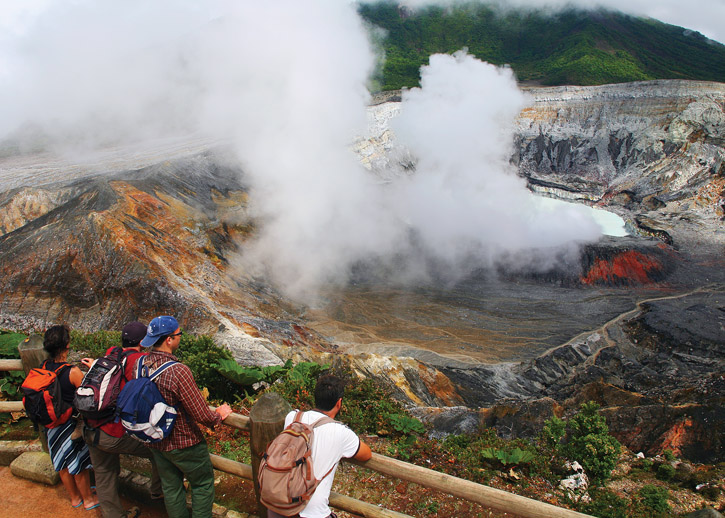There are few volcanoes where you can drive all the way to the rim. At Parque Nacional Volcán Poás you can—well, at least to within 300 meters (1,000 feet), where a short stroll puts you at the very edge of one of the world’s largest active craters, 1.5 kilometers (0.9 miles) wide. The viewing terrace gives a bird’s-eye view not only 320 meters (1,050 feet) down into the hellish bowels of the volcano, but also down over the northern lowlands.
The main crater bubbles persistently with active fumaroles and a simmering sulfuric pool that frequently changes hues and emits a geyser up to 200 meters (660 feet) into the steam-laden air.Poás (2,708 meters/8,885 feet) is a restless giant with a 40-year active cycle. It erupted moderately in the early 1950s and has been intermittently active ever since. The park is frequently closed to visitors because of sulfur gas emissions. Over the millennia it has vented its anger through three craters. Two now slumber under a blanket of vegetation; one even cradles a lake. But the main crater bubbles persistently with active fumaroles and a simmering sulfuric pool that frequently changes hues and emits a geyser up to 200 meters (660 feet) into the steam-laden air. The water level of the lake has gone down about 15 meters (50 feet) during the past decade, one of several indications of a possible impending eruption; after 12 years of silence, in March 2006 a series of explosions caused the park to close temporarily. In the 1950s a small eruption began to push up a new cone on the crater floor: The Cono Von Frantzius is now 80 meters (260 feet) high and still puffing.
Poás Volcano National Park, Costa Rica’s most visited national park, stars an active volcano. Photo © Christopher P. Baker.
A walk of 600 meters (2,000 feet) on the Sendero Sombrilla de Pobre connects the parking lot to the crater lookout. The 800-meter (0.5-mile) Botos Trail, just before the viewing platform, leads via a surreal dwarf forest to an extinct crater filled with a cold-water lake called Botos. This trail and the 530-meter (1,700-foot) Escalonia Trail, which begins at the picnic area, provide for pleasant hikes and are wheelchair accessible. The dense forests are home to emerald toucanets, coyotes, resplendent quetzals, sooty robins, hummingbirds, frogs, and the Poás squirrel, which is endemic to the volcano.
As often as not, it is foggy up here, and mist floats like an apparition through the dwarf cloud forest draped with bromeliads and mosses. Clouds usually form mid-morning. Plan an early-morning arrival to enhance your chances of a cloud-free visit. On a sunny day it can be 21°C (70°F). On a cloudy day, it is normally bitterly cold and windy at the crater rim; dress accordingly. Poás is popular on weekends with local Ticos, who arrive by the busload. Visit midweek if possible.
The park (tel. 506/2482-2424 or 506/2482-1227, adults $10, children $1) has a visitors center (tel. 506/2482-2424, 8am-3:30pm daily) with restrooms, a souvenir store, and a café, plus an exhibit hall and an auditorium where audiovisual presentations are given on Sunday. The park has no accommodations, and camping is not permitted. Parking costs $2.50.
TUASA (tel. 506/2222-5325) buses depart San José ($5) at 8:30am daily from Avenida 2, Calles 12/14, via Alajuela. The journey takes 90 minutes. Return buses depart at 2:30pm daily. TUASA (tel. 506/2442-6900) buses also leave from Alajuela at 8:30am daily. Tour operators in San José offer day trips to Poás (half-day about $35, full-day $55).
Excerpted from the Tenth Edition of Moon Costa Rica.